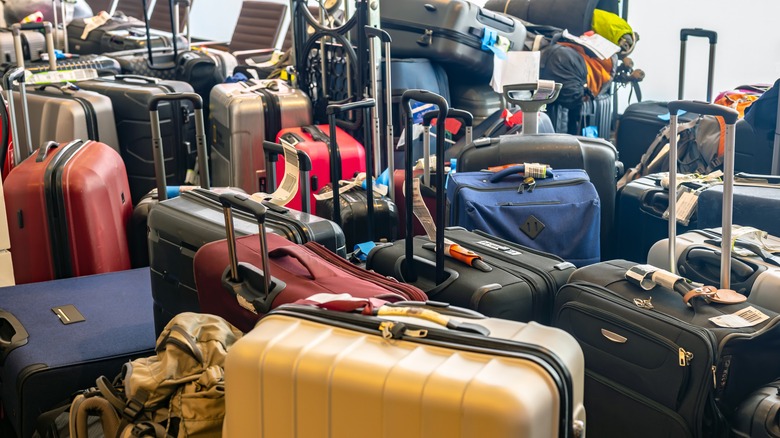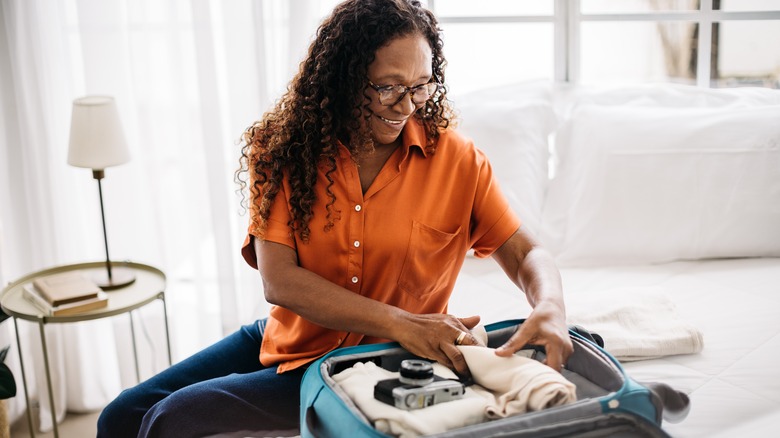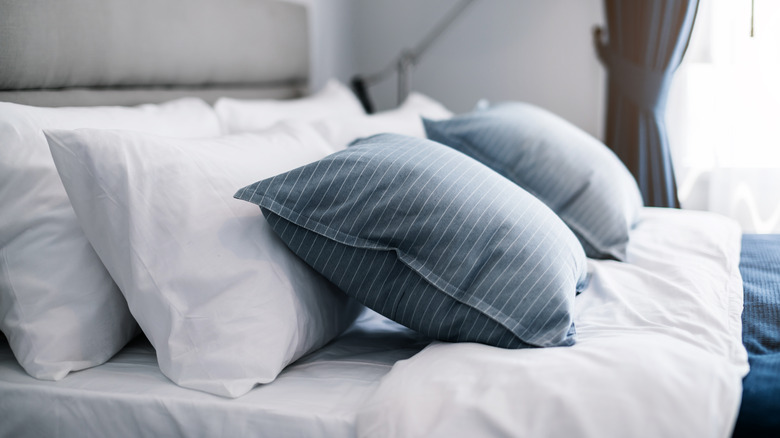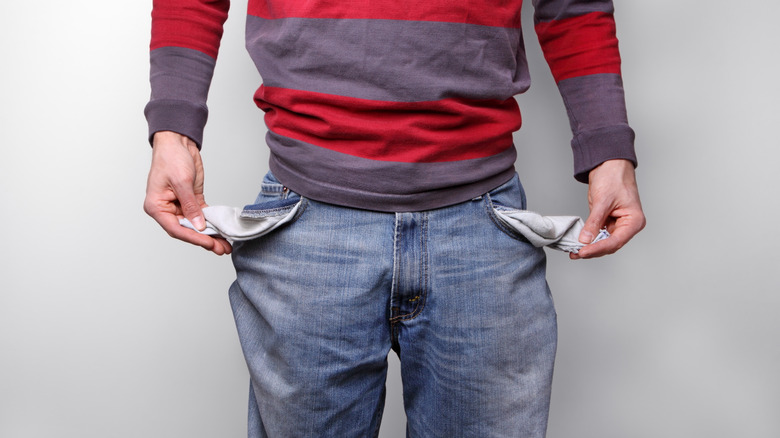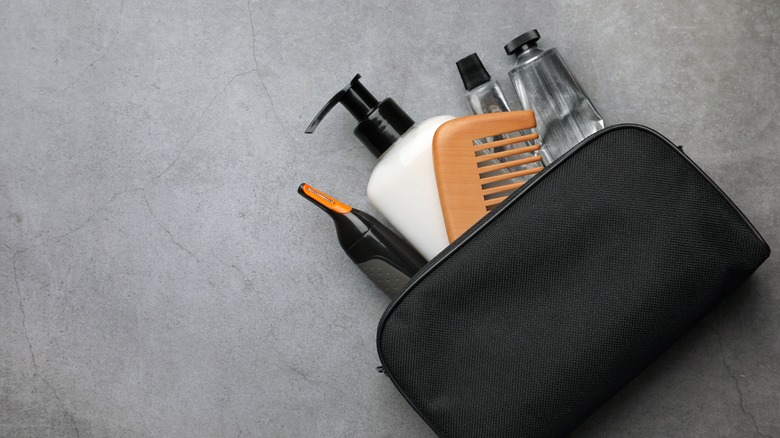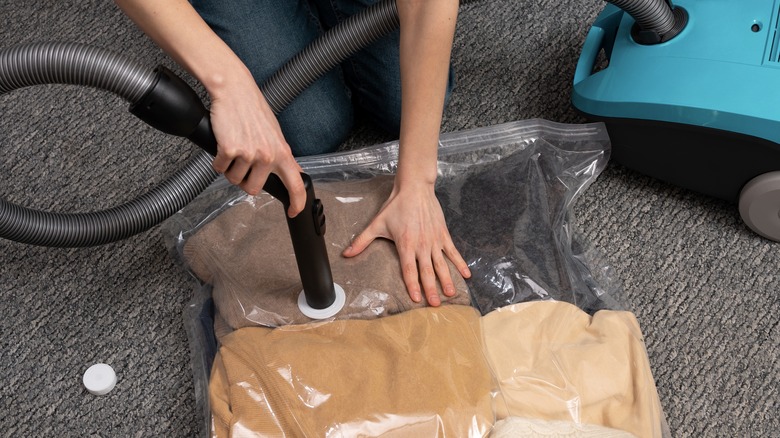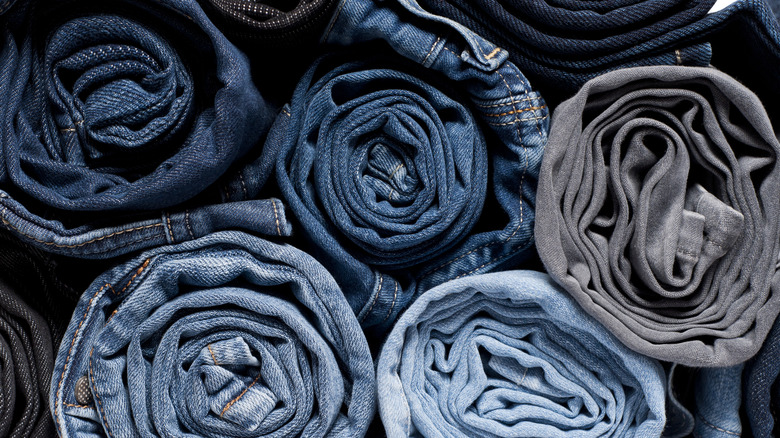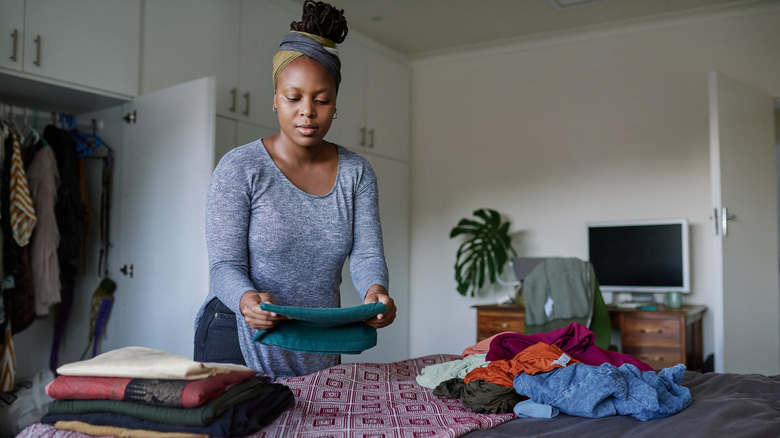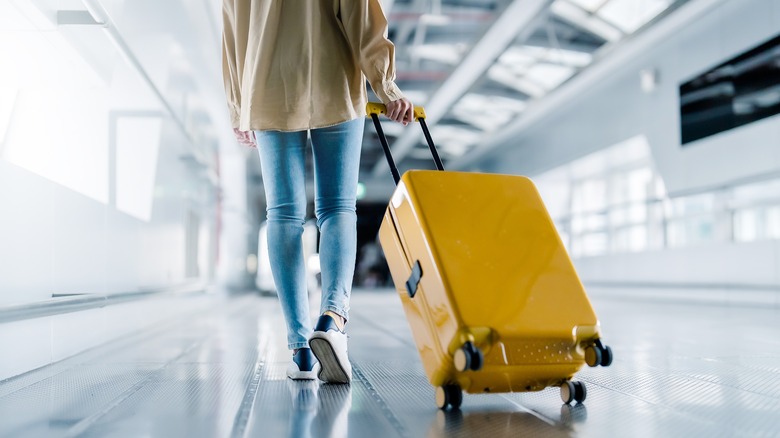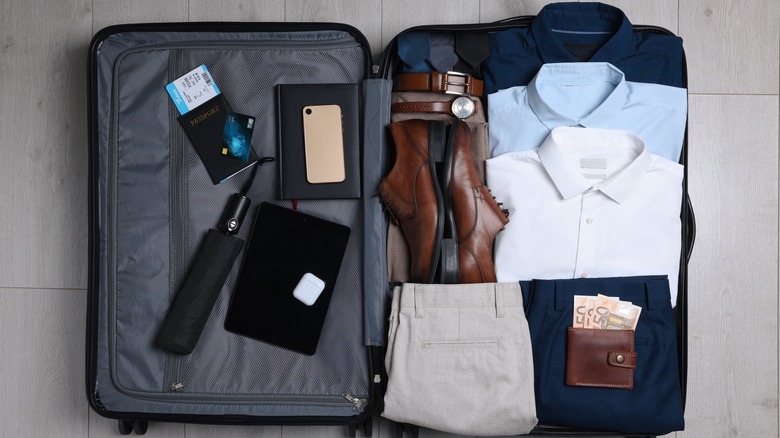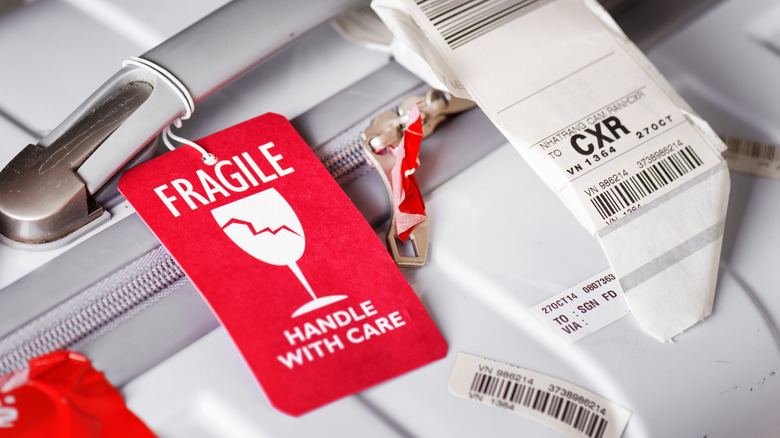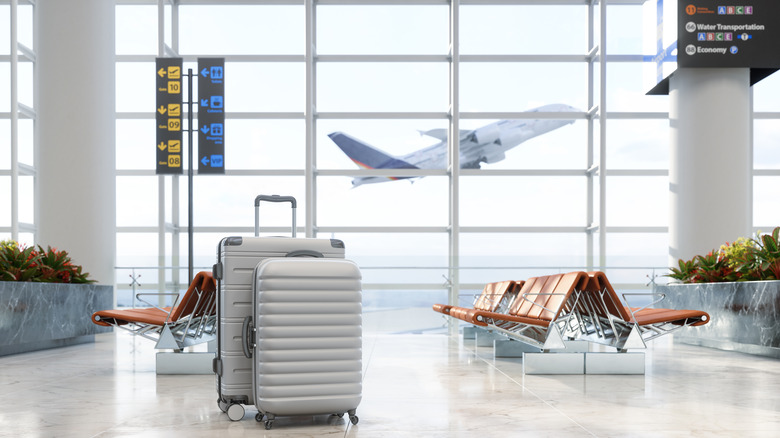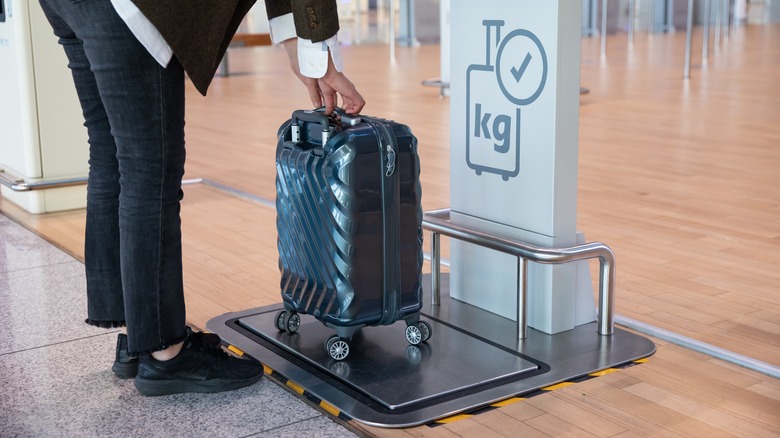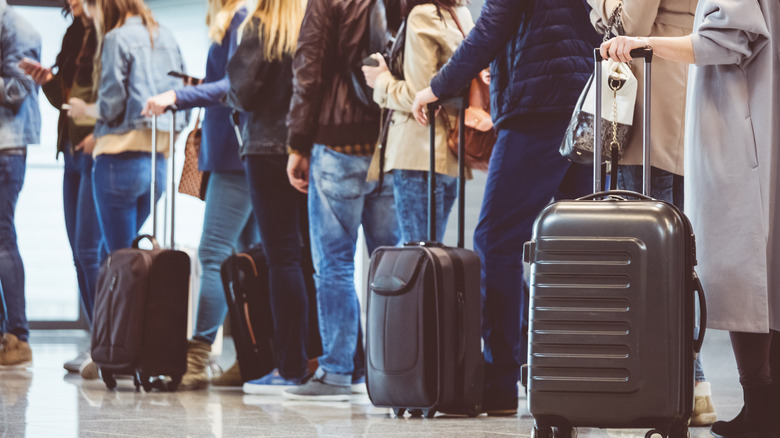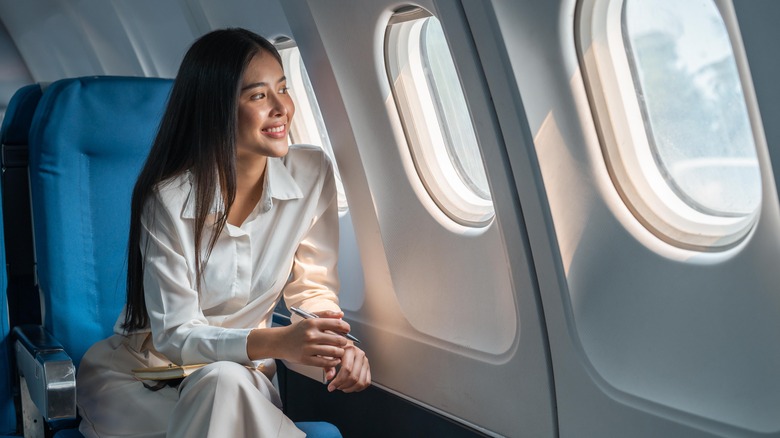Get The Most Out Of Airline Baggage Policies With These Hacks
Fees, fees, fees. There's a fee for everything these days, especially for things that never had a fee before. Convenience fees. Processing fees. Application fees. Some of the most egregious of the bunch are the never-ending fees you pay for air travel.
Not too long ago, almost every airline let you bring two checked bags for free. Seat selection fees were a laughable prospect — seats were doled out based on who booked first. And those extra legroom seats? Seats used to be bigger. They've been shrinking in pitch so quickly that maybe someday bare minimum legroom will come at a premium by default. There are even whisperings of airplanes going with standing seats, and other nonsense, to tighten the screws even more on the consumer.
While we can't provide any assurance that the situation will get better, we can offer some tips on how to make the most of the migraine that is flying. Specifically, ways to leverage those stingy baggage allowance policies so you get the best bang for your buck. Join us as we examine some tried-and-tested baggage hacks you can put to use on your next flight.
Wear your heaviest clothing
When the checked bag goes over the 50-pound limit, it's everyone's first instinct to remove those travel books or shampoo bottles, but you'd be surprised how much weight your clothes contribute. So for your next flight, wear as much of your heavy clothing as is realistically possible. Heavy coats, long-sleeved shirts, pants, heavy-heeled dress shoes or boots, and so on.
Yes, it will be more uncomfortable than lounging in shorts and sandals on the plane, but this minor inconvenience could easily save you a few pounds of luggage — and some extra packing space — for the trouble. Airlines can't do anything to regulate how much clothing you wear (within reason, of course). Besides, you can take off that jacket and those chunky boots once you're onboard.
It shouldn't need to be said, but use common sense here. Some individuals go overboard with layering on the clothing and end up getting fined, such as an Australian teen in this story by WION News. Then there's the risk of heat exhaustion that heavy clothing poses, as one British teen learned the hard way when wearing a reported 12 layers of clothing. BBC reports that after throwing up, going unconscious, and requiring oxygen, he was told by paramedics that he was lucky to be alive.
Put heavy things in your carry-on and personal item
If you're struggling to get the checked luggage weight down to something reasonable, then consider relocating a heavy item or two to the carry-on. For domestic flights, carry-on weight limits are next to nonexistent. You could theoretically have a bag full of raw bullion and no one would stop you. Plus, your most fragile items are often the heaviest (such as electronics) so you get to keep them out of the occasionally careless hands of baggage handlers.
International flights often impose a 20 to 25-pound weight limit on carry-on, but with experience as a guide, they rarely weigh carry-on bags either at the check-in counter or at the gate. Things are too hectic, and airports too understaffed, so airline personnel will be on the lookout for only the most flagrant violations.
Your personal item is also in this nebulous void of not having weight limits. So your backpack or purse can become a repository for any end-of-the-road reshuffling you need to do to manage luggage weight. Just double-check that your personal item is actually a personal item in the airline's eyes — some budget airlines have begun to crack down hard on defining what exactly a personal item is and is not.
Try the pillow hack
Speaking of things in that nebulous void of no weight limits, pillows are another. Like clothing, airlines won't even do a double-take if you walk onto a plane with a pillow to sleep during the flight. This led TikTok hacker @nolimitua to use her pillowcase for extra storage space — and by pillow, we mean an actual bed pillow, not a U-shaped neck one. Her hack allegedly went off without a hitch. Here's to hoping pillows don't start to accrue their own fees when other people try the same.
If you're the sort that can't get any meaningful shuteye after take-off (or if you don't mind a hard "cushion" made of your t-shirts and underwear) then see if you can't use an old pillowcase as a jerry-rigged piece of luggage. We'd recommend only using it only as overflow for a few extra clothes. A misshapen, lumpy pillow is bound to catch the eye of an airport official, leading to an awkward scenario where you have to dump out the contents for everyone to see. Admittedly, this hack is on the fringes of ways to cheat the baggage allowance, one that requires you to keep track of yet another "bag." The pillow hack serves best only as a last resort.
Wear clothing with extra pockets
Remember in the mid-'00s when goth kids were wearing those loose-leg pants with enormous pockets running down the sides? In the current year, they might have had the right idea for bringing more onboard the plane. Pockets, like personal items and pillowcases, are yet another means of bypassing conventional baggage restrictions. Cargo pants and shorts let you carry tons of small items on your person for free — as long as you don't mind offending the gods of fashion.
Another solution — a not-so-fashionable clothing item that's less likely to make nearby fashionistas grind their teeth — is a travel vest. It's a vest with a ton of hidden, internal pockets that make your baggage-skirting efforts much less obvious, one that's more likely to gel with your outfit. Keep in mind that whichever method you choose, it's going to rear its ugly head in the TSA line once you have to remove your pockets' contents — unless you remembered to renew your TSA PreCheck membership. Travel vests are ideal for storing your valuable electronics while already on the plane.
Buy some essentials at your destination
We spend so much time seeing if we can pack something that we never stop to think about whether or not we should. There are a ton of items better to buy than to pack, particularly toiletries. Others, such as blow dryers, typically come standard at your hotel. Weather-contingent things like umbrellas and sunscreen will only cost you a few dollars and are bound to be available at the place you're going to if it requires them.
This hack is especially useful if you're a chronic over-packer and know you're going to exceed the limits. Buying a few dollars worth of toiletries will run you a lot less than paying overweight baggage fees. If the idea of buying shampoo and conditioner in another country only adds stress to your journey, then consider pre-ordering toiletries and other necessities. This option is available at a select few airports via a company like Boots' Click & Collect. In short, you buy your toiletries and pick them up after security — thus avoiding TSA troubles and not having to worry about the weight it adds.
Use duty-free shopping bags
You thought we'd run out of storage mediums that are exempt from weight limits? You thought wrong. There's yet another: your duty-free bags. See, airports work very hard to make you spend as much money as possible while waiting for your flight, as Mental Floss can attest. Duty-free is one of their many cash cows. It would really ruffle the feathers of tired travelers if they couldn't bring their expensive mineral waters and overpriced perfumes onto the plane, so duty-free doesn't count as baggage at all.
You can probably see where this is going. To sneak extra luggage onto your flight, use the duty-free bag hack. You might try asking for a free bag from one of the duty-free stores or — if that doesn't work — buy one small, cheap item and then use the rest of the bag as you please. Just be aware that your duty-free bags don't get diplomatic immunity; airline staff may search them, and they may check their contents against your receipt. We really only recommend this gamble in the event of an overflowing bag, or a flight where you know they'll check-in your carry-on.
Use space bags and packing cubes
Space bags and packing cubes are quickly becoming the norm for seasoned travelers thanks to their ability to better maximize such limited packing allowances. Space bags use vacuum-sealing technology to compress clothes down to their smallest possible form factor. Whether you're going to Paris for fashion week, or Costa Rica with a suitcase full of board shorts, space bags will squeeze it all down to leave room for things that matter. The only real downside is that space bags trick you into loading your bag down with more weight, so keep an eye on that scale.
Packing cubes are a close cousin that helps organize your suitcase into sectors. They're a boon whether you're on a short weekend escape or living out of a suitcase since they give all of your items their own space. Just make sure you know how to use packing cubes efficiently; they're not black magic that will Mary-Poppins your suitcase into order. If you're underweight and in desperate need of more space, using one or both of these travel tools will be invaluable.
Roll, don't fold
To roll or to fold: That is the question. One travel blog might tell you that folding your clothing is the most efficient way to pack; another says no, rolling is clearly superior. CNET put both methods to the test and found that rolling clothing is the most space-efficient of the two, allowing for an additional three items' worth of space. Only a few articles like bulky sweaters, structured clothes, and formalwear don't benefit from rolling.
Plus, rolling makes it easier to grab clothes you need without digging through — and disrupting — an existing pile. It also makes it easier to organize things into packing cubes since you can fold the garment in half before rolling to get a thicker — albeit shorter — roll. Then there's the added benefit of wrinkle prevention, except for some button-down garments that might get more wrinkled than if you'd just folded them.
Build a more versatile wardrobe
Clothes still weighing you down? We get it, your once-a-year trip doubles as a faraway photoshoot to update your social media with new pics. The more outfits you bring along, though, the bigger your luggage caravan will be. It might be time to adopt a versatile wardrobe that makes better use of the clothing you do have.
By versatile, we mean articles of clothing that can play many roles. Say, a pair of walking shoes that double as dress shoes for a swanky dinner, or a pair of pants that work for hiking as well as a casual stroll. This hack is most effective when you have the means to do laundry at your destination, such as a vacation rental with an on-premises washing machine or a hotel's complimentary laundry service. This could also help to cut down on weight that you might need later to fit souvenirs.
Check your carry-on bag
Looking to get an extra checked bag without paying a cent? There may be a solution that's normally a pain in the rear for most travelers. You've probably noticed in recent years how airlines seem determined to force later boarding groups to check their carry-on bags at the gate. Most believe it to be an issue of overhead carry-on space — a problem that might not be so bad if some clueless individuals stopped using the overhead bins to stow items that belong under their seats. Others argue it's a way for airlines to speed up the boarding process.
Whatever the actual reason, it presents a chance for you to check your carry-on completely free of charge on busy flights, especially international ones. Unless you're using the carry-on to keep your fragile and valuable items, that means one less bag to worry about until you arrive at your destination. If the airline doesn't require you to check your carry-on, ask them for a complimentary gate check. Most are dying for volunteers and will be overjoyed if you beat them to the punch.
Use the inside of your shoes
Your shoes take up a ton of space in your suitcase, especially if you're one of those poor, unfortunate souls cursed with boats for feet. Aside from wearing your biggest shoes, there's not much you can do to bring down their size. Dress shoes, as one example, don't take kindly to being squished and may get stretched or bent if you do so. It doesn't help that shoes already present a challenge when finding a configuration in your suitcase for them that takes the least amount of space.
With that said, you can use the inside of your shoes as packing space. There's a surprising amount in there for socks, pill bottles, and anything else you'd rather not leave sitting loose. The inside of your shoes is especially good at protecting delicate items such as an electric razor — though do be sure to secure it in a plastic back for hygienic reasons.
Ask for a fragile tag or sticker
Your fears that baggage handlers beat your luggage senseless are warranted. Year after year, we get some video of them hurling SwissGears like they're trying out for the shot put. One potential solution to this is to use their own system against them. When at the check-in counter, ask the attendant to put fragile stickers — or tags — on your checked bags.
Now, this does not bestow your bag with some holy shield of protection against abuse. Some baggage handlers ignore the fragile sticker entirely. They're on the lookout for items that look fragile, such as guitar cases. It's still worth a shot, but make sure your fragile sticker was issued by the current airline. Old stickers get ignored.
You can also look for luggage that actually protects its contents. Get rid of that soft-sided suitcase and upgrade to a hard-shell one, since handlers are no more gentle with the former. Also, make sure your suitcase has plenty of handles — ideally one on the top and side. Baggage handlers are trying to work quickly, so if they can't reach a handle, they'll just throw your bag however is easiest and least strenuous. If everything we've just said makes you even more anxious, then it might be time to get some baggage insurance.
Buy a lightweight, expandable suitcase
While we're on the topic of suitcases, there's a good chance it's time to retire the old ones your family has been passing down from generation to generation. The best luggage for every traveler will depend on specific needs, but we have two particular recommendations in mind to make the most of baggage policies.
First, get an expandable bag. These have an extra zipper along the side that, when opened, expands the bag out another handful of inches to increase your packing space. They're a great choice if you'd rather not have to carry a wagon train of suitcases through the airport — or pay for an extra checked bag.
Second, buy a suitcase made of strong, high-quality, lightweight materials. Newer soft-side luggage uses heavy-duty synthetic weaves that will last for years. For hard shells, polycarbonate or composite materials offer exceptional durability while weighing a fraction of what an aluminum case would. Just keep in mind that unless you plastic wrap them, they're going to accumulate some scratches over time.
Buy a portable luggage scale
For most, the issue isn't that you have too much stuff, just that you're struggling to get the weight distribution right across multiple bags. This isn't helped by the fact that you've probably only got a bathroom scale for weighing your suitcase, forcing you to play the hop-on, hop-off game. And unless you've got someone to help, you then have to contort into a very uncomfortable position with a heavy suitcase to catch a glimpse of the scale readout.
Save yourself all that annoyance and inconvenience by buying yourself a portable luggage scale. You can find them at online retailers for as little as $10. They make it easy to weigh your suitcases, and they're lightweight, perfect for bringing along during your travels without adding too much extra weight. Plus, you'll be better able to account for unexpected souvenirs before coming home. These luggage scales come in digital and analog options in the event you'd rather go battery-free.
Check in early
Airplanes have to play a careful balancing game with their weight thanks to, well, the laws of physics. Overweight fees aren't just to skim more money off the consumer, they're to discourage everyone from bringing suitcases full of bowling balls that would make the plane wheeze trying to get off the tarmac. Many travel blogs have suspected for years — without conclusive evidence — that airlines have a secret baggage quota. That is, they keep a tally of the entire plane's baggage weight and force people to jettison their extra weight the closer they get to reaching said quota.
Though it's only conjecture, you may have experienced something like it. On one flight, airline counter staff ignore bags that go over by a few pounds. On another, even a gram over incurs a penalty. With experience as a guide — again, this may not be true — arriving as early for check-in as possible means staff will forgive the excess weight. Arrive late, when the quota's near full, and you can kiss this hack goodbye.
Choose a different airline
Baggage policies vary wildly from airline to airline, and some are more miserly than Ebenezer Scrooge. Take Frontier and Spirit Airlines as two examples. Despite being low-cost airlines — ones you'd expect to save money on — they both charge an arm and a leg for carry-on and checked baggage. Meanwhile, other affordable airlines like Southwest give you two free checked bags on most of their flights. Even if an airline does allow you to bring on a carry-on or personal item, they may be incredibly draconian in enforcing the size requirements — Ryanair being one example. A too-big carry-on bag will cost you on other airlines like EasyJet.
The solution? Get an airline that treats you right with better baggage policies. In particular, be on the lookout not just for airlines with free carry-ons and checked bags, but above-average weight allowances. Qatar and Singapore lead the pack by allowing you a meaty 30 kg for checked bags, a huge increase over the vast majority of airlines. So before you book a ticket with an airline, factor in their baggage costs. That budget airline might not be so budget, all things told.
